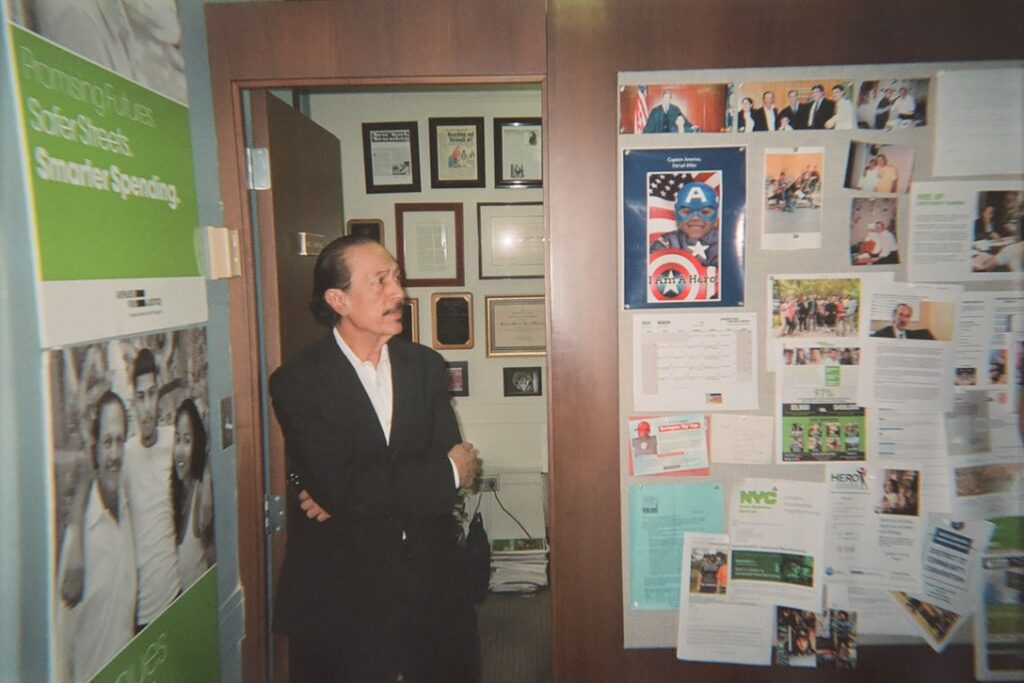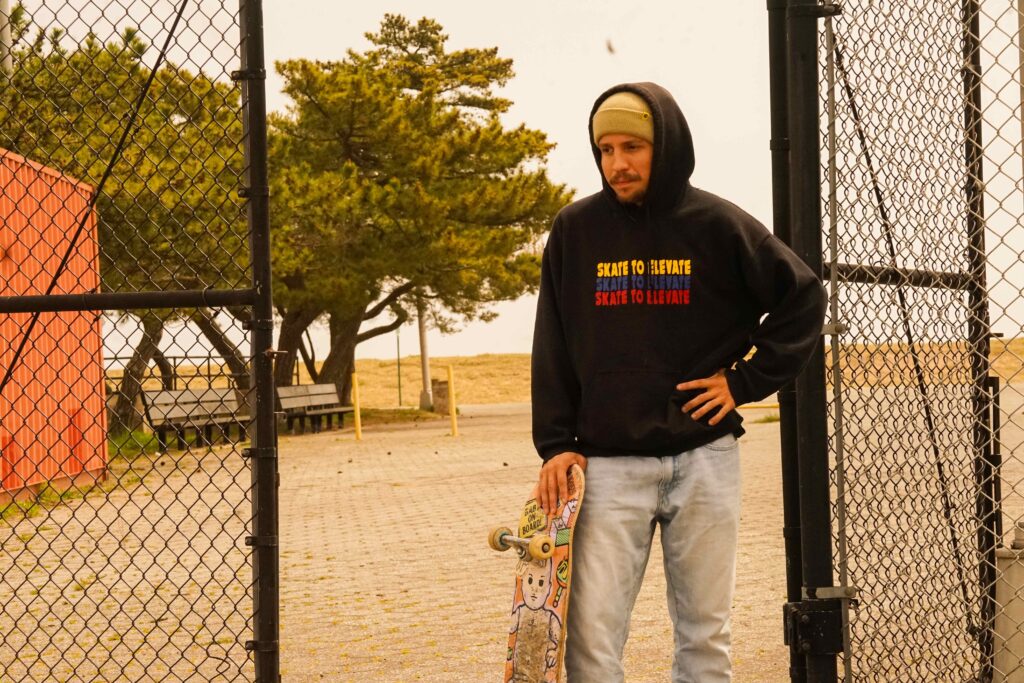This emblem of counterculture revolutionaries is prevalent as ever.
Twenty-one-year-old Ryan River lives off St. Marks Place, the legendary street in the East Village once highly regarded as a creative and political hub for writers, artists, musicians and changemakers alike. The type of place people move to because the lore is irresistible; you move here, you’ll find your people, your cause and you can become somebody. You might have to be a bit thrifty, because rent isn’t cheap and neither is food or groceries, but at least you are being fed creatively.
River doesn’t make a cent from Favorite Color Magazine, the zine he started in October 2023 about the punk + alternative music scene in New York City and New Jersey. The jagged edges of River’s typed writing that he cuts into strips, and places next to underexposed band photos, reveal human imperfections.
River is from a lot of places, but like the many creatives before him, he found his community in New York City. Last August, he started as a freshman comics major at the School of Visual Arts. Since living in the city, he’s discovered a new love, outside the confines of art school, that allows him to pursue his favorite art form: writing.
“90% music, 10% whatever else,” River’s tagline reads. Much of the pages consist of Q&As accompanied by images in black and white of local bands, ads for people in search of band members, upcoming shows, booking resources, lessons and a few playful doodles and scribbles.
River, whose favorite color is #96b0cc, has shaggy, bleached blond hair and a snake bite piercing. An interjection during our interview (Dana from Village Works recognized Ryan), led us after to wander down the street to the bookstore, which houses and promotes many local zines. Their designers draw inspiration from the city and its unparalleled creativity.
* * *
What purpose do zines serve in a social media/internet blogging world? Historian and museum curator Drew Sawyer would like to propose an answer to this question.
Sawyer moved to the city in the early aughts and got to experience a boom of queer zine making firsthand. It was before the social media landscape was oversaturated — and less authentic — and physical media was still very hot. Essentially, before social media took over the world.
Over twenty years later, an exhibition Sawyer co-curated for the Brooklyn Museum, Copy Machine Manifestos: Artists Who Make Zines, had a section dedicated to this time period.
Although everyone’s chronically online now, there is still a desire to be a part of an if you know, you know society. Zines, with their small circulation and limited editions, allow for that.
“I think, realistically, if you look at the number of zine fairs happening, even in New York City alone, there’s so many every year,” Sawyer says.
Beyond that, in a post-pandemic world, there is “something attractive about the materiality of printed zines,” Sawyer says. The anti-establishment is still there, which has allowed for zines to continue to thrive in a way that online and social media apps likely will never be able to.
Although they’ve never died, they are going through a spike in creation — inspired by idle time during the pandemic that led to a creative itch some people just needed to scratch.
* * *
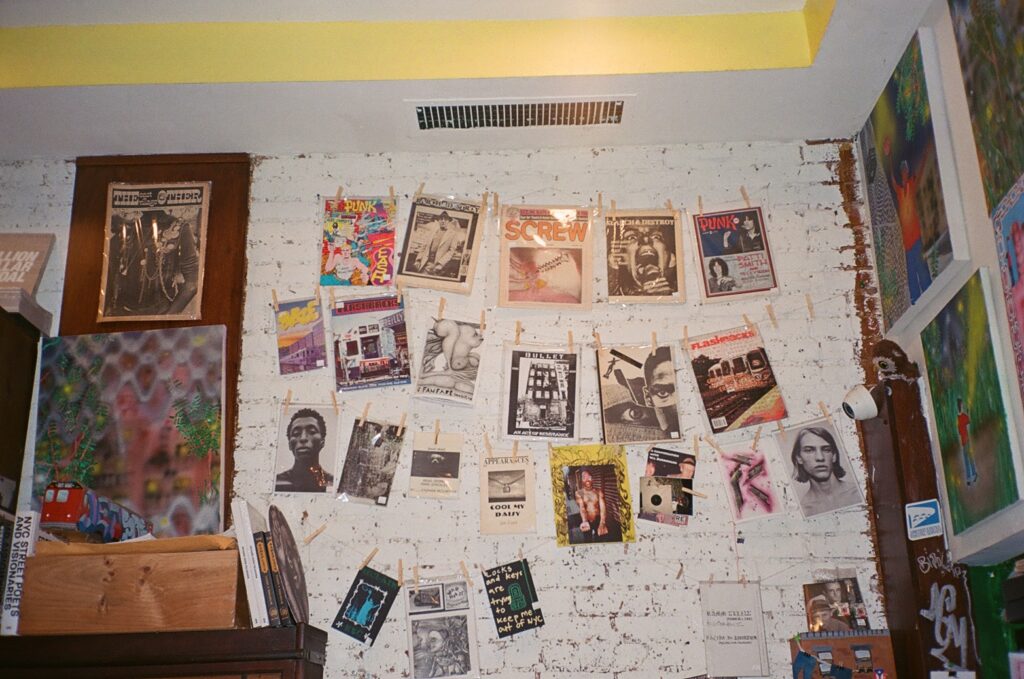
Erin Gray, 25, was working as a barista during the pandemic, which she had no intention of doing full time when moving to the city post-grad. ‘I could be a barista kind of anywhere,’ she thought. What she really wanted was to participate in something that better aligned with her artistic passions, but it was the thick of the pandemic and she couldn’t direct a play from her living room couch. So, she started brainstorming other collaborative art forms she could explore, and soon after The Living Room zine was born.
Gray sent out invitations to people she had crossed paths with within theater and arts communities: friends, collaborators, peers. By the end of the first issue, Gray had an old friend-turned-collaborator, who began assuming an editor role of sorts.
Gray has known Eva Szilardi-Tierney, 24, since middle school — their paths have been unexpectedly aligned since the early days. They’re both from Berkeley and attended the same high school and college. They ended up moving to New York with their partners within a month of each other.
Gray has curly brown hair cut into a pixie style and round tortoise glasses. She talks with her hands, often gesturing largely in an excited way, which is visible even through a Zoom screen. Szilardi-Tierney has short, dark brunette hair with messy curtain bangs. They are quieter than Gray, nodding encouragingly or occasionally chiming in to add on to Gray’s thought.
Gray is the Living Room’s artistic director and Szilardi-Tierney is the managing editor, though they haven’t decided on official titles.
“I’m a big daydreamer, I’m a big schemer, I’ve got a million plans going anytime and thinking too big for my britches,” Gray says.
“That’s what makes you,” Szilardi-Tierney responds.
Gray places a particular accent on the peer review aspect of their editing/zine creation process. “Our goal is really to facilitate spaces for artists to connect and create together and get to be in conversation about the work that they’re making with each other and put their work in conversation with each other,” Gray says. “It’s just really exciting when you get a photographer and a playwright and painter and an essayist, getting on Zoom together and talking about ‘grotesque’ and like, ‘What does grotesque mean? Or what does utopia mean? What are these concepts?”
* * *
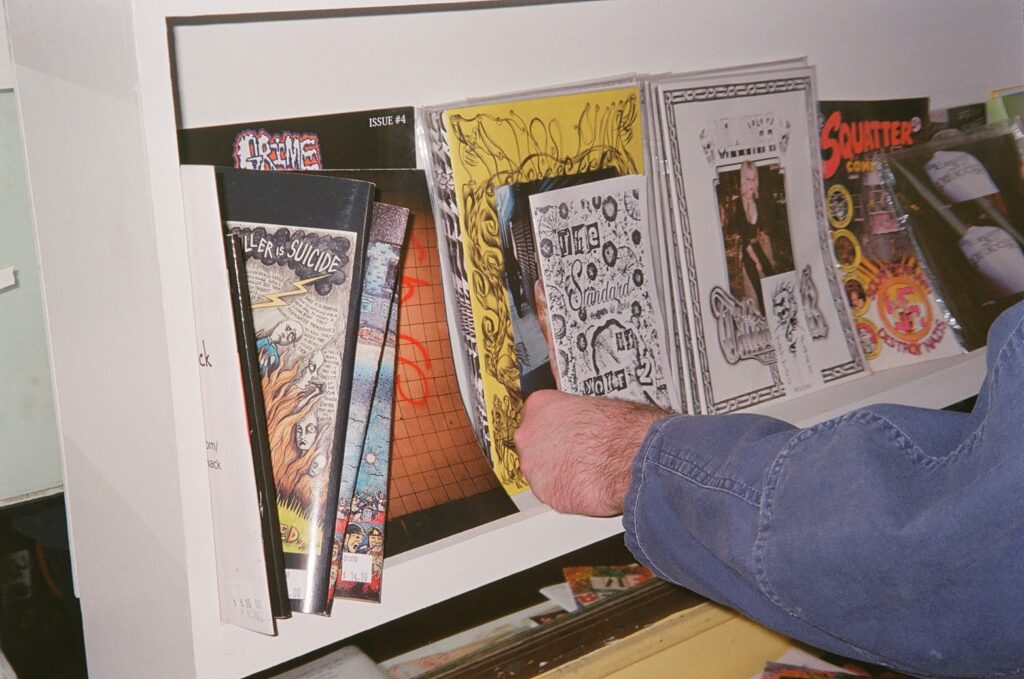
The creators of Post No Bills, Tyler Exum and Alex Loukopolous, draw lots of inspiration for their zine from NYC, particularly the nightlife and the punk design of late 90s and early 2000s magazines and zines. The New York City natives (Tyler’s from Harlem, Alex is from Queens) are both writers, though their focus areas are different.
Exum draws inspiration from Beyoncé, Issa Rae and Michaela Coel, and Loukopoulos from Steve Jobs, Fiona Apple and David Carson (they both find themselves inspired — to some degree — by the controversial Azealia Banks).
The idea to start Post No Bills was naturally a result of their environment. It was in the aisles of the Brooklyn College Library that Post No Bills was born. A portion of the library is dedicated to zines and zine culture. Its collection consists solely of print zines and the topics are related to Brooklyn life, student interests, curriculum and zine making as a whole.
Exum, Loukopolous and I had to share a sofa when we met on a Tuesday afternoon in a crowded hotel lobby. When I sat down, nestling myself in between the two of them, they handed me a copy of the second issue of their zine. Its vibrant orange cover stood out among the muted tones of my other belongings.
Loukopoulos has blond hair that has just surpassed the grown-out buzz cut phase and the kind of dark green eyes that may be confused for brown in certain light. He’s slightly soft-spoken, not to the point of concern in normal conversations, but in a noisy room using a small recorder, it could be. He talks slowly like he’s carefully choosing every word in the same way a politician would.
Exum has big brown eyes and she was rocking waist-length, boho black braids when we met. She is petite, but speaks her mind more freely than Loukopoulos. She’s fashionable in the way you’d expect someone working in a creative field would be.
A good attention-grabbing name is so important for something like this. Why Post No Bills? It’s essentially free advertising, Loukopolous says. The three-word phrase is displayed on construction sites everywhere in the city. Its ubiquity also allows others to derive meaning from its title that goes beyond what Loukopolous and Exum had in mind.
After the first issue, Exum and Loukopolous had strong feelings about its release, both positive but different outlooks. In a room surrounded by a community they’d rallied to support the release of their new project, Exum felt proud and accomplished and Loukopolous echoed this, but he also felt it was only the beginning. They both see Post No Bills expanding beyond just a zine or magazine.
“I know this magazine is going to be a huge deal. Like, fuck what everyone else thinks, honestly, you will see this magazine in all the magazine stores across the city,” Loukopolous says. “I know that there’s so much more that has to be done … This is only the first step.”
* * *
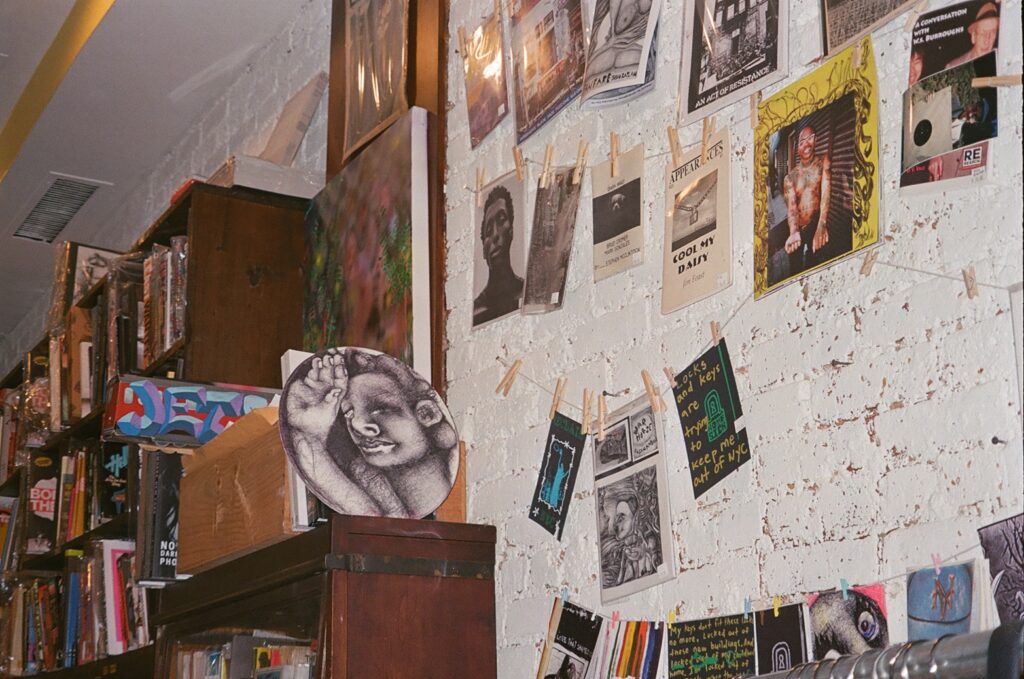
The process to create a physical zine seems straightforward: type/write, cut, paste, copy, fold, staple together, repeat, but mistakes can happen and prolong everything (isn’t that part of the beauty of the process?). For each zine creator it can look slightly different, though.
In his tiny apartment in the East Village, River makes the zine in the bedroom that he co-inhabits. He places a lot of emphasis on the DIY-ness of it all. The first issue was created on his bare mattress, prior to him having a bed frame or a desk. He uses a printer in his bedroom to print the typed writing and then cuts and pastes them together to create an original copy.
Similar to River, Gray and Szilardi-Tierney use Gray’s single-sided, roughly $100 Brother printer, that she “tricks” into printing borderless, but acknowledges it likely isn’t good for the printer.
“I would, like, hand collate it and then print alternate pages, flip it, reorder, print the other sides, and then we’d staple it,” Gray says. All of which was done in Gray’s living room.
Loukopoulos’ mom printed out the first two issues of Post No Bills and he and Exum folded and stapled them together, at one point cutting off the margins to create the clean, cohesive look. For the third issue they hope to go to a “legit” printer.
But printing is so expensive.
In February, Gray and Szilardi-Tierney experimented with using a printer near Gray’s apartment in Sunset Park. The issue printed a little darker than they would have liked, so they plan to continue experimenting with other print shops. They want to make sure the artists that contribute to The Living Room and their work are fairly represented.
The zine community has also allowed for expansion beyond the creation of this physical, written work to the exploration of other mediums as well, still in relation to what is discussed within the particular zine.
Creators of Favorite Color Magazine, The Living Room and Post No Bills seem to all share the same sentiment: if they could devote their entire beings to this they would, no hesitation.
“Favorite Color is my love,” River says. “If I was really rich or something … I would drop out and just do it full-time. I would [put] every single ounce of my energy into it.”


